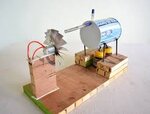eagle1109
Full Member level 6

- Joined
- Nov 20, 2014
- Messages
- 393
- Helped
- 4
- Reputation
- 10
- Reaction score
- 7
- Trophy points
- 1,298
- Location
- Saudi Arabia
- Activity points
- 5,956
Hello,
I don't know if this is the right place for my question,
I want to prepare the hardware parts for electronics project dealing with solar energy.
There are different routes for this project:
1. Use solar cells and just connect them to rechargeable lithium batteries with DC regulators.
2. Demonstrate one of the other technologies; like, parabolic troughs, concentrated tower or heliostat.
My questions are:
1. Which is the best route to go with, in electronics diploma project or in real life?
2. If I needed a steam engine, a small one for the project, where to find it? I didn't find it on Aliexpress.
I don't know if this is the right place for my question,
I want to prepare the hardware parts for electronics project dealing with solar energy.
There are different routes for this project:
1. Use solar cells and just connect them to rechargeable lithium batteries with DC regulators.
2. Demonstrate one of the other technologies; like, parabolic troughs, concentrated tower or heliostat.
My questions are:
1. Which is the best route to go with, in electronics diploma project or in real life?
2. If I needed a steam engine, a small one for the project, where to find it? I didn't find it on Aliexpress.




